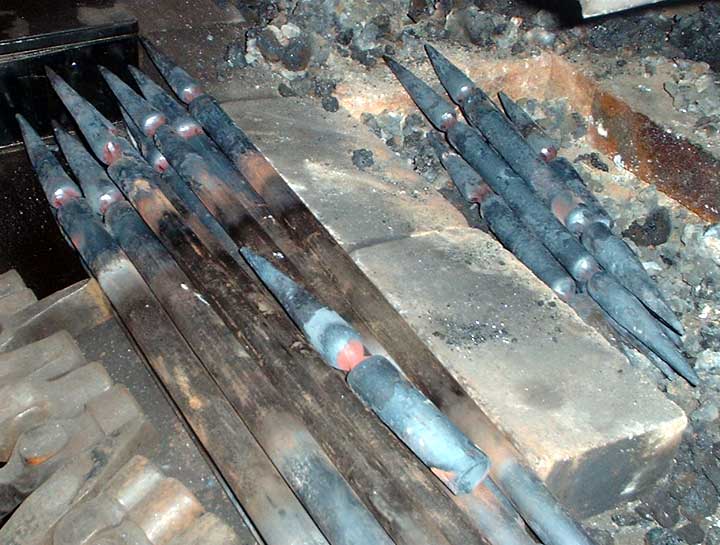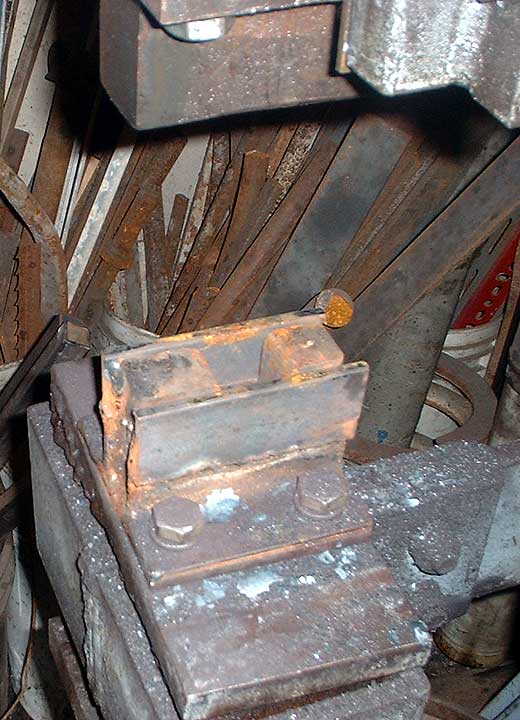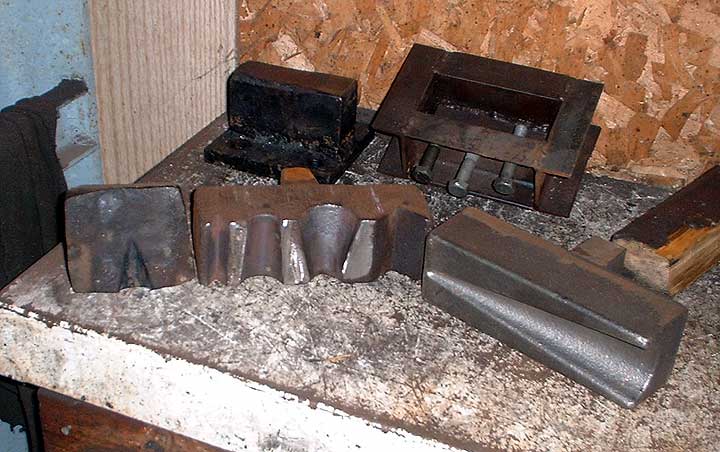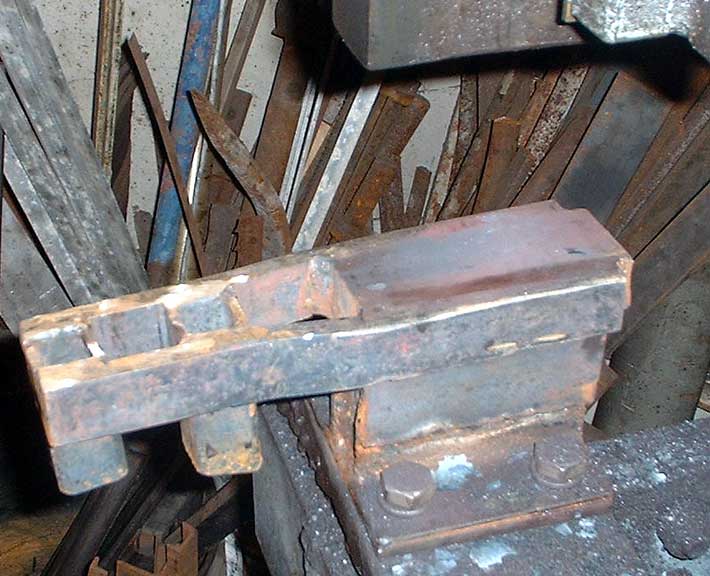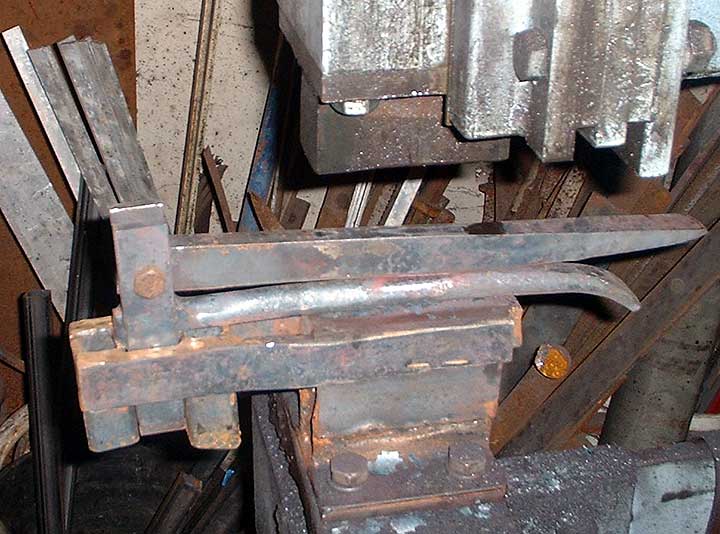From a posting prepared for NORSEFOLK. References had been made to metal casting, ore smelting and hammer forging. There is a general set of problems with any hot work, and then specifics related to each of those activities.There are a number of quite important and extremely serious safety problems to be considered when working hot metals. There is further a huge ramification into the Viking Age - and further how re-enactors chose to emulate history.
Some general safety:
Eyes:
The single most disastrous event. All of the processes can (and do!) result in pieces of hot materials flying around, often significant distances. A single drop of water inside a casting crucible converts it into a cannon firing molten metal. Modern safety glasses, with side shields , are absolutely required - period. For casting and aspects of smelting, a full face shield WORN IN ADDITION is necessary. (Even then I have gotten fragments under a face shield, and past safety glasses and into my eyes!) This is my one hard and absolute rule in all metalworking.
In addition, when working with incandescent materials (all three) I seriously recommend the use of
didydium lenses. I personally also use a welders lens ON TOP for forge welding and smelt extraction. My rule of thumb is 'if I look away and see spots - its time for a darker lens'
* There is no such thing as a blind blacksmith! *
Clothing:
Everything said earlier applies. One large gap - ALL NATURAL FIBRES. For modern use, cotton is fine. Avoid things like polar fleece, all those poly-cotton blends (they melt). There are arguments to be made about tight or loose clothing. Loose clothing does keep debris further from the body. At the same time it can leave folds and pockets, plus gathers of fabric to catch up tools during fast actions. Tight clothing means anything striking is right close to the skin. Personally, I tend to favour tight under loose (see the next addition).
A full bib leather apron solves many problems, it shields from heat radiation (huge problem with casting and smelt extraction), and most hot debris do not stick to it.
Although not mentioned, footwear should ALWAYS be heavy soled boots. These need to come up under the pants, and be secured tight at the tops. So above the ankle work boots, laced all the way up, with the pants pulled down over the tops.
Gloves present a special problem. Although certainly required for the hands, open cuffs tend to collect and hold flying pieces. (I've gotten some of my worst burns from material bouncing off my chest, then into the open cuff, which then holds the material on to my skin.) Professional fireman's gloves have tight cuffs to prevent this. This creates a second problem - the gloves themselves so over heat that they themselves can burn the skin. Its hard to get a tight cuff glove off when you are in a hurry, a problem often seen in casting and smelting. So my solution to this is to wear a large gauntlet type welder's glove, over a tight knitted Kevlar glove liner. (Kevlar does not burn.) The combination solves both problems.
Some kind of cap is certainly suggested. If nothing else because there is going to be ash and fine dust everywhere. Hair can also trap flying hot particles. A lot of people favour a slouch or bush hat style, which keeps stuff from falling down their necklines.
So now consider applying that to a Viking Age world.
In DARC (and all my own museum programing work) the standard is:
'History STOPS when safety STARTS'.
I insist that modern safety equipment be used, and authenticity be dammed. It is also historically accurate to be blinded by a working accident...
Clothing does not generally present a major problem. Wool is hot for the wearer, but is actually the ideal fabric to wear around hot metals. Pick a relatively tight weave, and the stuff is actually very difficult to burn. Viking Age male styles actually provide a very good coverage, a fairly close fitting linen over a loose wool with a small neck, worn belted over loose pants - provides good protection. (My wife even made me up some special 'smelting pants' which have a double layer of fabric on the front surface.)
Gloves are gloves. The true authenticity focused can sew up their own, but a modern welding glove in grey or natural is not that different than a historic one.
A leather apron is a leather apron, again no historical problem.
My team (as you have seen) is working towards a full Viking Age iron smelt - a presentation actually at L'Anse aux Meadows NHSC (for August 2010). We have been considering how the remaining two required safety equipments, boots and eye protection, can fit inside a Viking Age framework.
We have been discussing making up some additional leather protection. Perhaps a set of leather 'sleeves' (we currently use a pair made from fire suit materials). Longer aprons that hang to at least the knees a good idea as well.
For boots, we figure we will make up modified versions of the high boot found at York England. This fits to maybe 6 inches above the ankle, with long straps that wrap the upper tight to the leg. Most likely we will fit double thick leather soles (which does not show in wearing). We can cut thin aluminum or steel 'insoles' to be placed under a standard thick felt insole. That arrangement is again invisible, but provides both comfort and and extra measure of safety. There is no easy way to provide for top of the foot protection that I can see.
On eye protection - I just refuse to work WITHOUT proper modern safety glasses (and forbid anyone involved to work without it as well). In my 30 years of demonstrating before the public in historical contexts, I have never had anyone from the public 'complain' about my use of proper modern eye protection. So the first level of eye protection is established.
Normally we only wear the full face shields for the short extraction and primary consolidation phase of the smelting operation. (And during any metal casting pours, even in historic demo.) For the LAM presentation, I may just use the modern shields for the brief period of frantic activity that marks the extraction. Our audience is certainly going to be too focused on that process to note historical modifications!
This does however bring up the problem of 'what did they do'?
The evidence I have looked at for Viking Age iron furnaces suggests most were designed for top (as opposed to bottom side) extraction. In top extraction, the last charge of charcoal is allowed to burn down till it is almost to the level of the bloom and its enclosing slag bowl. There still will be some burning material remaining (you do not want to uncover the bloom completely), and the interior temperatures of the furnace are in the range of 2400 F plus at that point. Someone has to reach down and work over the top of this! First the remaining charcoal is scooped out. Then the bloom is hammered in place to compact and loosen it. Next the iron mass needs to be pried loose (sometimes a difficult task) and then snatched out with large tongs. All this is done standing over and looking down into that hot furnace.
 Top Extraction - November 2005
Top Extraction - November 2005Frankly, you just can NOT do any of this without something shielding your face. (In fact, I have melted two standard clear plastic shields right off my head in past efforts!). The radiant heat would physically burn your eye balls without some kind of protection.
What has been suggested is a leather mask with long slits cut into it. The shape would mimic a modern face shield, so protection of the face is ensured. The slits would function the same way a pair of snow goggles do, limiting the amount of both light and heat passing through the shield. Light is not a problem, if anything, this arrangement would reduce the too bright interior of the furnace. It may prove necessary to fit the slits with a thin film of mica to block 100 % of the heat.
There would be some kind of balance historically between skilled and unskilled, amateur and professional - all balanced against potential risk. I doubt a blacksmith or a bronze caster working in Jorvik would do much more than squint. The mechanics of iron bloom extraction suggest the requirement for some, if limited, protective gear. What it may have been, we are very likely to never be able to know. As re-enactors, some balance must be struck between modern realities (don't maim your friends!) and historic possibilities. Those who have decided to maintain authenticity standards so tight as to permit only proven artifacts in use may be best advised to avoid such high risk demonstrations as smelting and casting altogether.



